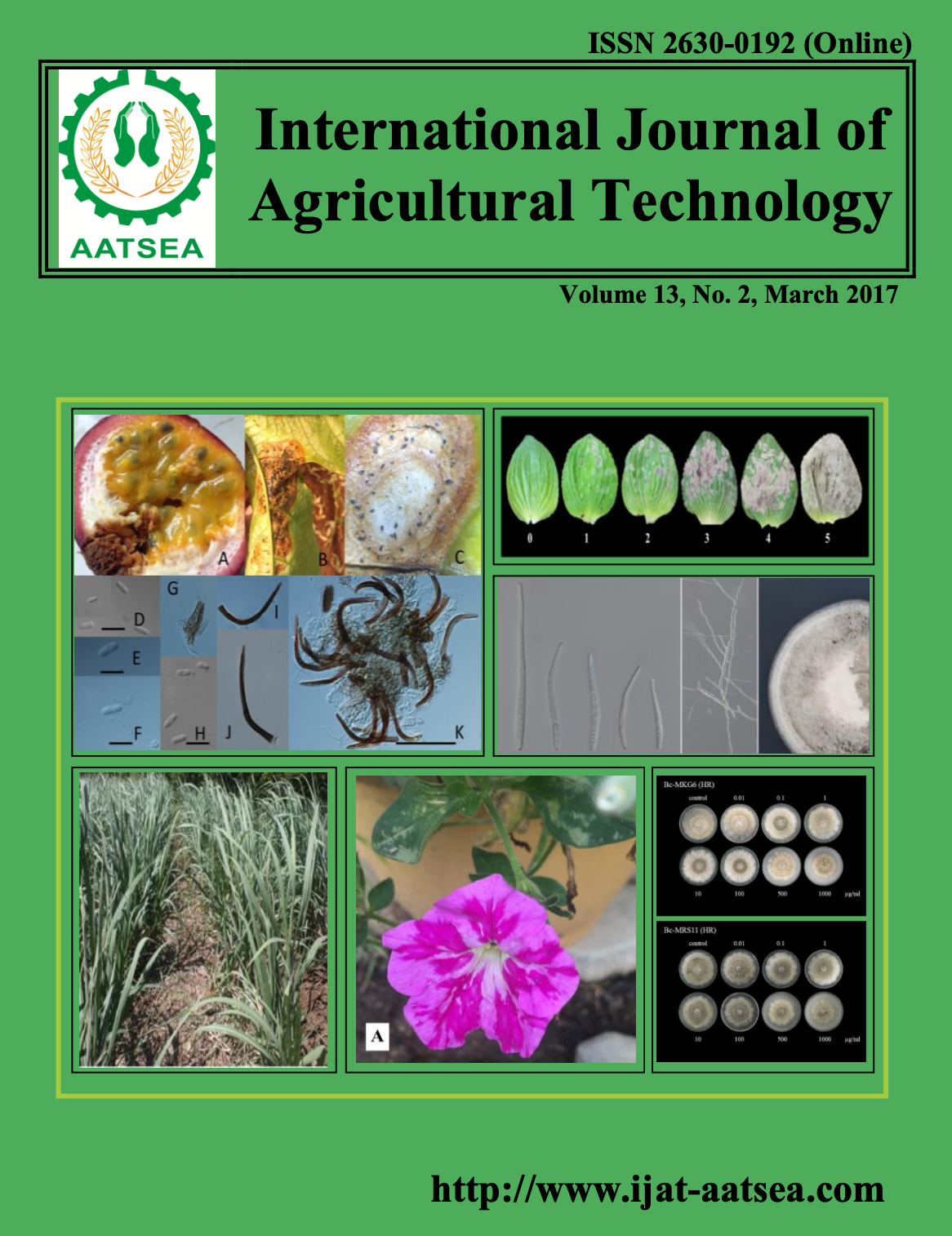Screening for plant extract, antagonistic microorganism and fungicides to control Ganoderma boninense caused stem rot of oil palm in vitro
Main Article Content
Abstract
The basal stem rot of oil palm caused by Ganoderma boninense has been reported as the severe disease in growing area, a few studies of this disease was reported in Thailand. This research was carried out to screen plant extract, antagonistic microorganism and fungicides for control Ganoderma boninense caused stem rot of oil palm in vitro. Plant extract from leaves of Antigonon leptopus and Carica papaya; rhizome of Zingiber montanum, Curcuma longa and Zingiber offcinale; and latex of Carica papaya was test by poison media technique. The result showed that all of plant crude extract were not the high effective control of this pathogen. The highest was Carica papaya with mycelium growth inhibition 41.26 %. The indigenous antagonistic microorganism isolated from rhizosphere showed the high efficiency to control this pathogen was antagonistic bacterial isolate B001, B002 and B003 and antagonistic fungus isolate T003. For fungicides, in vitro screening, prochloraz, kresoxim methyl and chlorotalonil was the high efficacy control Ganoderma boninense with mycelium growth inhibition percentage of 96.22, 98.96 and 88.44 % respectively.
Article Details

This work is licensed under a Creative Commons Attribution-NonCommercial-NoDerivatives 4.0 International License.
References
Amini1, J. and Sidovich, D. F. (2010). The effects of fungicides on Fusarium oxysporum f.sp. lycopercici associated with fusarium wilt of tomato Journal of Plant Protection Research 50:172-178.
Ann, P. J., Chang, T. T. and Ko, W. H. (2002). Phellinus noxius brown root rot of fruit and ornamental trees in Taiwan. Plant Disease 86:8.
Badalyan, M. S., Innocenti, G. and Garibyan, G. N. (2004). Interactions between xylotrophic mushrooms and mycoparasitic fungi in dual-culture experiments. Phytopathological Mediterrianian 43:44-48.
Bruce, A. and Highley, L. T. (1991). Control of growth of wood decay Basidiomycetes by Trichoderma spp. and other potentially antagonistic fungi. Forest Production Journal 41:63-76.
Diczbalis, Y., Henriod, R., Sole, D. and Campbell, T. (2014). Evaluation of the use of prochloraz in the control of postharvest disease of papaya in Australia. Acta Horticulture 1022:133-142.
Idris, A. S., Ismail, S., Ariffin, D. and Ahmad, H. (2002). Control of Ganoderma infected palm – development of pressure injection and field applications. MPOB Information Series No 148. 2 pp.
Jamkratoke, S, Rattanakreetakul, C. Leksomboon, C., Farungsang, N. Wanichkul, K. and Farungsang, U. (2004). Effects of Boesenbergia rotunda, Curcuma longa and Zingiber officinalis extracts on postharvest disease fungi. In Proceedings of 42nd Kasetsart University Annual Conference: Plants, Agricultural Extension and Communication, Bangkok, Thailand. pp. 521-528.
Limsriwilai, P., Likhitekarat, S. and Surin, P. (1984). Diseases of oil palm in Thailand. Agricultural Research Journal 2:221-228.
Najmie, M. M. K., Khalid, K., Sidek, A. A, and Jusoh, M. A. (2011). Density and ultrasonic characterization of oil palm trunk infected by Ganoderma boninense. Disease Science Review 11:160-164.
Mavuso, Z. S., and Niekerk, J. M. (2014). Development of a more effective postharvest treatment for the control of postharvest diseases of avocado fruit. South African Avocado Growers AssociationYearbook 36:23-26.
Muirhead, I. F., Fitzell, R. D., Davis, R. D. and Peterson, R. A. (1982). Post-harvest control of anthracnose and stem-end rots of Fuerte avocados with prochloraz and other fungicides. Australian Journal of Experimental Agriculture and Animal Husbandy 22: 441-446 .
Pornsuriya, C., Sunpapao, A. Srihanant, N., Worapattamasri, K. Kittimorakul, J., Phithakkit, S. and Petcharat, V. (2013). A survey of diseases and disorders in oil palms of southern Thailand. Plant Pathological Journal 12:169-175.
Prusky, D., Kobiler, I., Akerman, M., Miyara, L. (2006). Effect of acidic solutions and acidic prochloraz on the control of postharvest decay caused by Alternaria alternata in mango and persimmon fruit. Postharvest Biological Technology 42:134-141.


